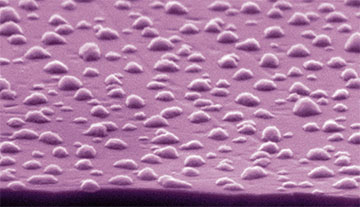
Scanning electron microscope image of the copper dewetted nanoparticles with antimicrobial properties over the glass substrate. [Image: ICFO]
Researchers from the Institute of Photonic Sciences (ICFO), Spain, and Corning Inc., USA, have created a transparent nanostructured copper surface that adds antimicrobial properties to glass (Commun. Mater., doi: 10.1038/s43246-024-00472-w). They say the surface, designed to be applied to touch screens, is resistant against the growth of certain bacteria while allowing for up to 80% light transmission in the visible range.
“While further development is necessary for full-fledged commercial deployment, this is a step in the right direction to enable antimicrobial touch screens for public or personal displays,” said study author Prantik Mazumder, Corning Inc., in a press release accompanying the research.
An ancient antimicrobial
Traditional methods to disinfect personal and multi-user touch-activated displays include sprayable alcohols or wipes. Previous work has explored nanostructured or ultrathin metals and their oxides, such as titanium dioxide and zinc oxide, as a coating applied directly to the glass. However, these coatings are light-activated and not suitable for indoor use.
The current study looked at copper, a material exploited for its natural antimicrobial properties by the ancient Egyptians and Greeks. Copper has been leveraged in hospital equipment like bedrails and intravenous stand poles, but such coatings are opaque and therefore not applicable to display screens. In addition, the high electrical conductivity of copper can interfere with the touch functionality of electronic devices.
The researchers took a novel approach that involves thermal dewetting of an ultrathin copper film to form dewetted copper nanoparticles of an optimal size for the antimicrobial effect, transparency, color neutrality and electrical insulation. Layers of silicon dioxide and fluorosilanes were deposited on top of the copper nanoparticles for environmental protection and improved durability.
Rigorous testing
Tests of antimicrobial effectiveness demonstrated more than a 99.9% reduction of Staphylococcus aureus present on tested surfaces in the span of two hours.
Tests of antimicrobial effectiveness demonstrated more than a 99.9% reduction of Staphylococcus aureus present on tested surfaces in the span of two hours. Optical testing determined that the surface had a color-neutral optical transmission between 70% to 80% in the region 380 to 750 nm. Lastly, abrasion testing that consisted of 730 or 1,200 wipes with Lysol- or isopropanol-impregnated scouring pads revealed that the surface still retained its antimicrobial and optical properties.
“This new approach of considering the dewetting process opens to a variety of new possibilities to exploit some specific properties of metals while being able to thoughtfully change the others,” said study author Alessia Mezzadrelli, ICFO, in a press release. “Here for example, we were able to preserve the powerful antimicrobial effect of the copper while obtaining transparency and insulation despite the use of a metal.”
